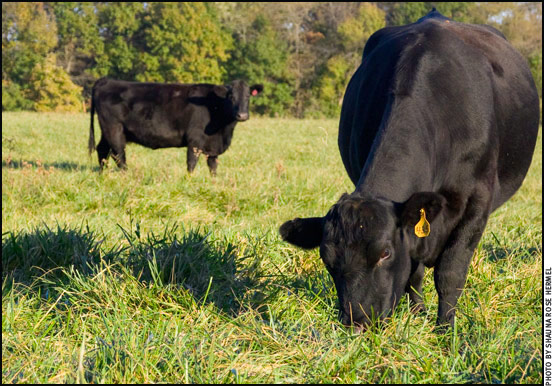 Time for Nitrogen
Time for Nitrogen
MU Greenley Center visitors get timely tips on growing fall stockpiled feed for beef cows.
When it comes to winter feed for beef herds, applying a pound (lb.) of nitrogen to pastures in August gives a good return. A pound of nitrogen fertilizer makes about 20 lb. of forage dry matter, Justin Sexten, beef nutritionist, told Greenley Center Field Day visitors Aug. 9. Five wagonloads of visitors participated in the beef tour at the MU research farm east of Novelty, Mo.
Cattlemen can feed hay and distillers' byproducts to cows in the winter, but for ease of feeding and nutrient value, it's hard to beat stockpiled fescue pasture, said the University of Missouri Extension specialist.
"This is something you can take home and use now," Sexten told beef producers. "Mid-August until September 1 is the time to clip or graze pastures down to a 4-inch height." Then apply about 50 lb. of nitrogen per acre, and wait for the fall rains to activate growth.
"It will rain again," Sexten assured herd owners who have survived a prolonged hot, dry summer. "I just don't know when, or how much, it will rain."
Sexten added that if you wait for the rains to come before applying fertilizer, it will be too late. "The early growth is the fastest. Later in the season, grass grows slower."
With nitrogen at 55¢ per pound, a price mentioned by a visitor as a current local cost, the feed will cost less than 3¢ per pound of dry matter.
If you can buy hay for less than $50 a ton, that would be competitive, Sexten calculated. "However, it will be hard to find hay with the nutrient content of stockpiled grass."
There are other advantages of stockpiling, Sexten notes. The cows will harvest the grass. You don't have to haul baled hay to them or figure out how to store, handle and feed distillers' grain.
"A challenge with stockpiled forage is if rains are delayed. Alternative winter feeds may be needed," Sexten added. "Consider a balance of stockpile, hay or supplement such as DDGS (dried distillers' grains).
"People will say they don't have enough acres to set any aside ungrazed for 75 days. You don't have to think of stockpiled grass as the sole source of nutrients of the herd through the winter. Think of stockpile as a supplement. It can provide protein and energy lacking in a lot of hay put up this year.
"Then use an electric fence to open a strip of pasture for grazing — just enough to supply supplemental needs of the diet."
A hot wire makes for efficient use of stockpile. "If you turn 100 cows on 100 acres of stockpile, they will stomp half of it into the ground," Sexten says. Opening a narrow strip allows the herd to graze, and not waste, grass.
"You can keep moving the hot wire down the field," Sexten added. "You don't need to back-fence the strips."
At the current cost of DDGS, fall grass is a less expensive supplement for the winter hay.
Sexten also told how he uses a grazing wedge to inventory and monitor grazing paddocks at the MU Beef Research Farm in Columbia. Beef producers are now using the software, available on the MU website, to visualize how much forage is available in all paddocks.
"The wedge shows how little grass is left in the last paddock grazed and how much is in the next paddock to be grazed," Sexten said.
The graph should be a wedge. (To see wedges, go to
http://grazingbeef.missouri.edu.)
"If it is a flat line, that means all paddocks are overmature, or short on grass," he added.
 Future field days include Aug. 23, Graves-Chapple Farm, Corning, Mo.; Aug. 24, Hundley-Whaley Farm, Albany, Mo.; Sept. 9, Southwest Center, Mount Vernon, Mo.; and Sept. 29, Forage Systems Research Center, Linneus, Mo. Details are on websites for each MU research farm.
Future field days include Aug. 23, Graves-Chapple Farm, Corning, Mo.; Aug. 24, Hundley-Whaley Farm, Albany, Mo.; Sept. 9, Southwest Center, Mount Vernon, Mo.; and Sept. 29, Forage Systems Research Center, Linneus, Mo. Details are on websites for each MU research farm.
Editor's Note: This article was adapted from a release provided by the MU Cooperative Media Group.











